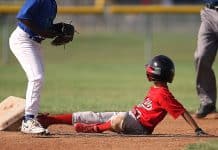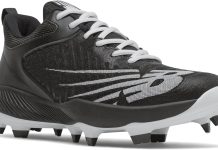If you’ve ever found yourself standing in front of a dazzling display of sports shoes, wondering how to tell the difference between baseball and football cleats, fear not!
This article will guide you in unraveling the mysteries of these sports footwear. Whether you’re a budding sports enthusiast or want to upgrade your shoe collection, understanding these two cleats’ key features and differences will help you make a well-informed decision. So, let’s lace up and get ready to learn!
As a sports enthusiast, I have always been fascinated by the differences between baseball and football cleats. While both cleats serve the same purpose of providing traction and stability to the players, they are designed differently to cater to the unique demands of their respective sports.
Football cleats are designed to provide better traction on grassy surfaces. They have longer studs that vary in length, depending on the player’s position. The studs are generally made of plastic and are detachable, allowing players to customize their cleats according to their needs.
Conversely, baseball cleats have shorter studs and are designed to provide better traction on dirt and grass surfaces. The studs can be made of rubber, plastic, or metal and are fixed in length.
The design of the cleats also differs in terms of support and protection. Football cleats have a higher ankle collar to provide additional support to the player’s ankle, which is crucial in a sport that involves a lot of lateral movements.
On the other hand, baseball cleats have a toe guard that provides added durability and protection the players need. The toe guard also allows for better traction on the balls of the feet, which is essential in a sport that requires a lot of running and quick movements.
Design and Construction
When choosing the right cleats for your sporting activities, it’s essential to understand the critical differences between baseball and football cleats. Each sport has specific requirements and demands, and the design and construction of the cleats reflect these needs.
Review contents
Upper Material
The upper material of cleats plays a crucial role in their overall performance and durability. Baseball cleats typically have a leather or synthetic leather upper. This provides excellent durability and protection against abrasion, which is essential considering the sliding and diving movements often required in baseball.
On the other hand, football cleats often feature a combination of synthetic materials and mesh to provide a balance between durability and breathability. Football involves significant running, so breathability is essential to keep the feet cool and comfortable.
Outsole Configuration
The outsole configuration of cleats differs between baseball and football cleats due to the varying demands of the sports. Baseball cleats are designed with a flat outsole to provide stability and traction on grass or dirt surfaces. The cleats on the outsole are typically molded rubber or metal, providing excellent grip while running, sliding, and making quick turns on the field.
Football cleats, on the other hand, have a different outsole configuration. They feature longer and more widely spaced cleats to provide superior traction on grass or turf surfaces. These cleats are often made of molded rubber, and some football cleats even have detachable metal cleats for added versatility.
Toe Cleat
Another distinguishing feature between baseball and football cleats is the presence of a toe cleat. Baseball cleats incorporate a toe cleat into their design to provide additional grip and stability when pushing off the ground during running or making quick movements. This toe cleat is essential for maintaining balance and preventing slips on the baseball field.
In contrast, football cleats typically do not have a toe cleat. This allows for greater flexibility and maneuverability when performing quick cuts and changes in direction on the football field.
Midsole Cushioning
The level of midsole cushioning also varies between baseball and football cleats. Baseball cleats often have thicker and more supportive midsoles to provide cushioning and shock absorption during high-impact movements, such as running or jumping. This helps to reduce the risk of injuries and provides comfort throughout the game.
Football cleats, on the other hand, typically have thinner midsoles to provide a more responsive feel for quick movements and agility. The focus is on lightweight construction to enhance speed and agility on the football field.
Specific Features
While baseball and football cleats share some similarities in design and construction, specific features also cater to each sport’s unique demands.
Baseball Cleats
Baseball cleats often have reinforced toe caps and ankle collars to provide additional protection and support during sliding and diving movements. These features help prevent injuries and ensure the cleats’ longevity.
Football Cleats
Football cleats are designed with features that enhance speed and agility. They often have a lower profile to provide a closer-to-the-ground feel, promoting quick and explosive movements. Many football cleats also incorporate technology such as lightweight materials and customizable lacing systems to enhance overall performance and comfort.
Stud Type
The type of studs or cleats on the outsole is an essential factor to consider when choosing between baseball and football cleats. The stud type affects traction, stability, and performance on different playing surfaces.
Baseball Cleats
Baseball cleats typically feature either molded rubber cleats or metal studs. Molded rubber cleats are versatile and suitable for both grass and dirt surfaces. They provide excellent traction while also being less aggressive on the field. On the other hand, metal studs offer superior traction on grass and dirt, especially in wet conditions. However, some leagues may restrict the use of metal studs due to safety concerns.
Football Cleats
Football cleats commonly come with molded rubber cleats or detachable studs. Molded rubber cleats are designed for use on grass or turf surfaces and provide reliable traction. Detachable studs, often made of metal or durable plastic, offer the advantage of customization. The length and type of studs can be adjusted based on the field conditions, allowing for optimal performance and traction.
Weight
The weight of cleats can significantly impact performance and comfort during sporting activities. Both baseball and football have different requirements when it comes to cleat weight.
Baseball Cleats
Baseball cleats are generally heavier than football cleats due to the added durability and support needed for the sliding and diving movements often required in the game. The additional weight promotes stability and helps players maintain their balance while running at high speeds.
Football Cleats
Football cleats tend to be lighter to allow for quick acceleration and agile movements on the field. The lighter weight helps players maintain speed and agility during gameplay and reduces fatigue throughout a match.
Ankle Support
Ankle support is essential for preventing injuries and maintaining stability during sports activities. Baseball and football cleats differ in their design and level of ankle support.
Baseball Cleats
Baseball cleats often incorporate additional ankle support features, such as padded ankle collars or higher-cut designs. These provide added stability to the ankle joint, reducing the risk of sprains and other injuries during running, sliding, or sudden movements on the field.
Football Cleats
Football cleats typically have a lower-cut design to provide greater freedom of movement and agility. The emphasis is on allowing the ankles to move more freely for quick cuts, changes in direction, and jumps. However, some football cleats may have a mid-cut design that offers more ankle support while maintaining flexibility.
Usage Surfaces
Baseball and football are played on different surfaces, and cleat design considers this.
Baseball Cleats
Baseball cleats are designed for use on both grass and dirt surfaces. The outsole is optimized for optimal traction and stability on these types of surfaces. The cleat configuration allows for excellent grip, preventing slips and slides.
Football Cleats
Football cleats are primarily designed for use on grass or turf surfaces. The outsole provides superior traction on these surfaces, enabling players to make quick cuts, changes in direction, and explosive movements without losing their footing.
Flexibility
Flexibility is essential in cleats as it directly affects a player’s ability to move and perform well on the field.
Baseball Cleats
Baseball cleats tend to have a moderate level of flexibility to allow for quick accelerations and changes in direction. While they still provide adequate support, the focus is on enabling players to move swiftly and perform the necessary movements of the game.
Football Cleats
Football cleats are designed with a higher level of flexibility to allow for agility and quick movements. The increased flexibility enables players to cut, juke, and change direction rapidly without being hindered by the shoe’s stiffness.

Cleat Shape
The shape of the cleats is another distinction between baseball and football cleats.
Baseball Cleats
Baseball cleats typically have a more rounded or bladed cleat shape. This design allows for better traction on grass or dirt surfaces. The rounded or bladed cleats help grip the ground without causing excessive damage to the playing field.
Football Cleats
Football cleats often have a triangular or conical cleat shape. The shape allows for greater penetration and grip on grass or turf surfaces. The triangular or conical cleats dig into the ground more effectively, providing stability and preventing slips.
Durability
Durability is crucial when choosing cleats, as sports activities can be demanding on footwear.
Baseball Cleats
Baseball cleats are designed with durability in mind. Using leather or synthetic leather in the upper material provides excellent resistance against abrasion and wear. Reinforcements in high-stress areas further enhance the cleats’ durability, making them suitable for the demanding nature of the sport.
Football Cleats
Football cleats also prioritize durability, but they often need to strike a balance with other factors such as weight and flexibility. The synthetic materials used in football cleat construction are chosen for their durability and ability to withstand the rigors of the sport.
Conclusion
In conclusion, distinguishing between baseball and football cleats is crucial in choosing the proper footwear for your sporting activities. Understanding the variations in design and construction, as well as specific features, stud type, weight, ankle support, usage surfaces, flexibility, cleat shape, and durability, can significantly enhance your performance on the field.
Remember, baseball cleats are designed with features that cater to baseball’s unique demands, such as sliding, diving, and running on grass or dirt surfaces. Football cleats, on the other hand, prioritize speed, agility, and quick movements on grass or turf surfaces. By considering these factors and selecting the appropriate cleats, you can optimize your performance and enjoy a comfortable and safe sporting experience.






































